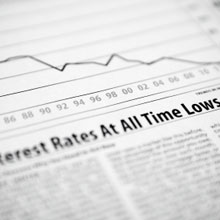By MoneyMorning.com.au
Financial repression. A few years ago when a few people (Gillian Tett, Russell Napier, etc) started predicting that it would be the thing that made our crisis go away, not many were convinced. The phrase refers to the various methods that hideously indebted governments use to channel the money knocking around an economy to itself rather than anywhere else.
It can include anything from capping interest rates on government debt or deposit rates (as seen all over the world at the moment); forcing institutions to buy government debt; or, at its most obvious, putting in capital controls to prevent anyone taking their money out of the country.
All these things have the same effective result: by taking away other investment options they allow governments to issue sovereign debt with much lower interest rates than they would otherwise be able to. That brings down the cost of debt nicely. But if you then chuck in a little inflation you can make the real value of the debt come down too. Keep that up for a couple of decades and you can repress your way out of trouble.
Financial Repression
This, of course, is exactly how many countries dealt with their horrible post-war debts: let’s not forget that the UK was subject to capital controls until 1979. However, even a few years back, there was a general view that in our new deregulated world, it wouldn’t be possible for governments to use these time-tested methods to get themselves out of trouble. Turns out that it is entirely possible. As Edward Chancellor pointed out in the FT, even in a time of apparently free capital movement, financial repression is entirely possible if everyone does it at the same time.
And doing it they are. “Negative real interest rates are to be found not only in the US but also in China, Europe, Canada and the UK”, where headline inflation is running at 3.4%, “far above both short and long-term interest rates… Western governments have learnt the lessons of history”, so they are all maintaining interest rates at levels well below inflation. At the same time, inflation is pushing up nominal GDP, and will in time “reduce the real value of outstanding debts, both public and private”.
But the authorities aren’t leaving it there. Far from it; they are going for more explicit repression as well. At the same time, everyone is pushing for their banks to hold more debt for “macro prudential reasons”.
And even when regulation isn’t actually put in place, political pressure is. An article in the Wall Street Journal late last year noted that “senior bank executives” from Italy and Portugal said they were being cajoled into buying government debt. Last year, the idea started circulating in Ireland that pension funds should be forced to sell foreign assets and buy Irish government debt. It makes no sense, said one commentator, that pension funds should hold bunds yielding 2-3% when they could hold Irish debt on 6-10%.
Hmmm. This year, Irish prime minister Enda Kenny is about to make it “easier” for pension fund managers to shift from bunds to Irish debt – by transferring the risk of holding it from the pension fund to the pensioner. Hungary has gone the whole hog and annexed pension funds. In 2010, for example, in an effective nationalisation of their private pension fund system, Hungarians were told to hand their private pension fund assets to the state or lose their state pension.
And capital controls? The idea sounds extreme to modern consumers, but they are certainly back under discussion (see Gillian Tett on them), and you could even argue that, in some ways, they are already with us.
The Long Reach of Uncle Sam
Those who work in the investment business will know of a new US regulation known as ‘Fatca‘ (Foreign Account Tax Compliance Act). Fatca is an extraordinarily wide-ranging, arrogant and intrusive piece of legislation (enacted in 2010) that requires all “foreign financial institutions” – that’s non-US banks, fund managers, custodians and so on, to tell the US taxman about all US taxpayers they deal with both directly and indirectly by the middle of next year.
This is quite clearly an admin nightmare (what is an ‘indirect client’?) so you might think that most non-US institutions would simply ignore it. After all, what jurisdiction does the US have over them? You’d think wrong. No one can ignore it: if they do, the Internal Revenue Service (IRS) will charge them a 30% withholding tax on all dividends, interest and sales proceeds made in the US.
The tax will begin to be deducted at the beginning of 2014. There will be no refunds. Failure to comply will also be a criminal offence under US law. How is this repression? It makes it harder for US citizens to invest abroad – already institutions, wary of the fact that they aren’t or can’t be compliant, are turning down US business until they see how the whole thing shakes down (how can you find out all you need to about all your clients and ‘sort of clients’ without running into confidentiality problems, for starters?).
The whole thing very dramatically changes the investing and tax landscape for Americans with money abroad. Worse, the crazy US rules won’t be the end of it. No, read this piece by William Hutchings in Financial News, and you will see that Fatca is about to go global.
Watch Your Back
“In the last three years, the Federal Reserve, Bank of England, European Central Bank and Bank of Japan have taken on an extra $10 trillion of debt, according to risk management consultancy CheckRisk, taking their collective balance sheet to $15 trillion.
“They are looking at every possible way to help pay it off. Ramping up their powers of tax collection is one of the few things they can do to help themselves. It is not such a big jump from there to the introduction of a global Fatca, an international framework obliging foreign financial institutions everywhere to act as tax collector for every government.”
John Redwood pointed out in his blog this week that the UK state is currently spending around 48% of GDP a year. Yet the maximum ever tax take is 38%. The gap has to be made up by someone – just as it does in every other Western country.
Financial repression creates that someone – by making a population hold debt that loses them money in real terms be it via their pension funds or banks, by cutting the return they get on their deposits, by upping their taxes and by letting inflation chip away at their assets. That someone is you.
Merryn Somerset Webb
Editor-in-Chief, MoneyWeek (UK)
Publisher’s Note: This article originally appeared in MoneyWeek (UK).
From the Archives…
Why Spain’s Economy is the Next Big Problem for the Eurozone
2012-03-30 – John Stepek
Water: A Long Term Trend to Follow
2012-03-29 – Patrick Vail
How to Avoid the Welfare State Hunger Games
2012-03-28 – Kris Sayce
What Happens When You Put Someone With No Market Experience in the Top Job?
2012-03-27 – Dr. Alex Cowie
The Star Stocks of the Resource Sector
2012-03-26 – Dr. Alex Cowie

Financial Repression: Why Every Bank Will Soon Be a Tax Collector for Every Government Everywhere

 Tradervox.com (Dublin) – The Reserve Bank of Australia is expected to leave the rates unchanged at its next meeting. The bank had reduced the interest rate in November and December but still remains the highest interest rate among the developed nations. However, according to Credit Suisse Group AG Index, traders are expecting a 0.74 percent cut on overnight swap rate.
Tradervox.com (Dublin) – The Reserve Bank of Australia is expected to leave the rates unchanged at its next meeting. The bank had reduced the interest rate in November and December but still remains the highest interest rate among the developed nations. However, according to Credit Suisse Group AG Index, traders are expecting a 0.74 percent cut on overnight swap rate. 









